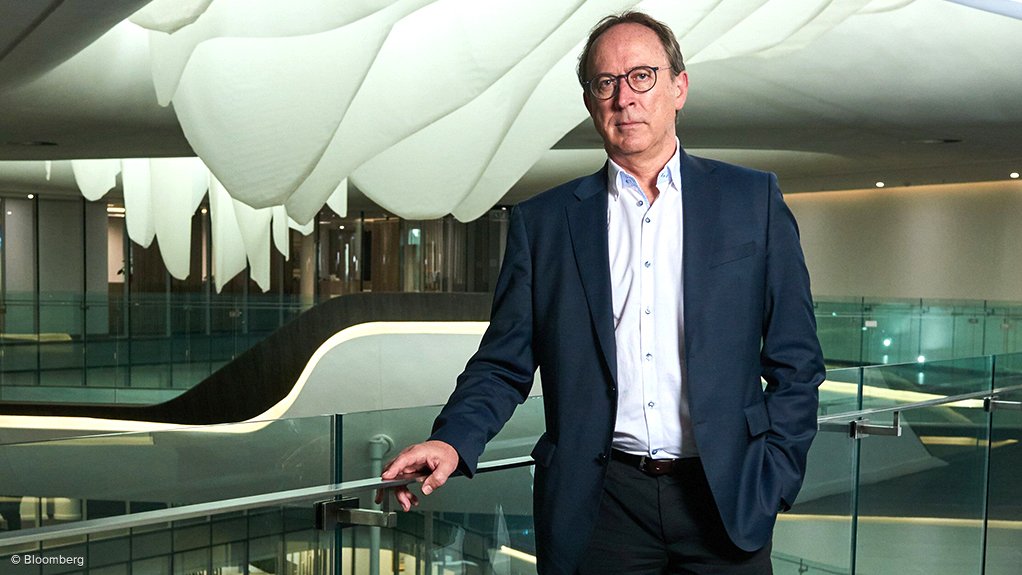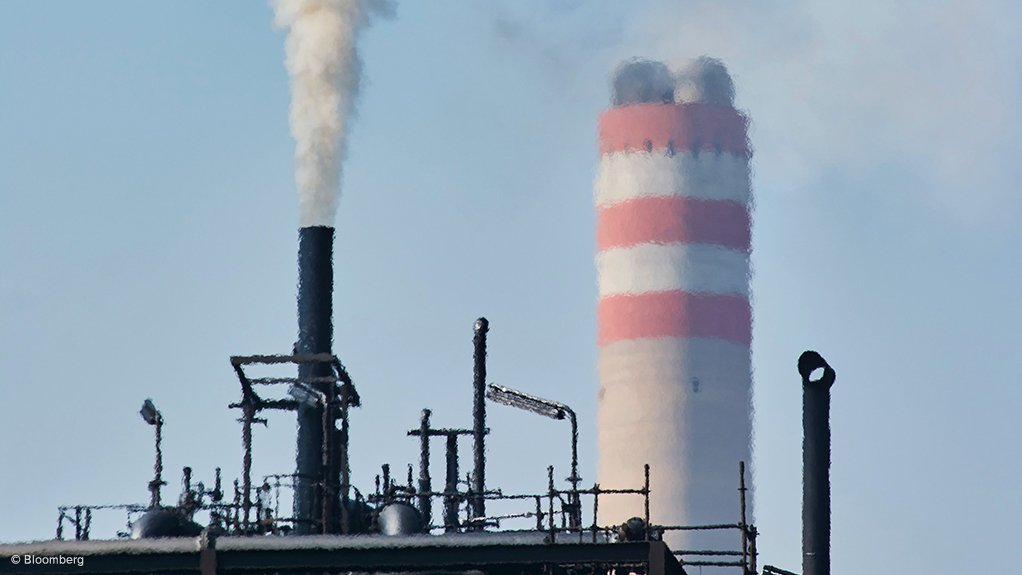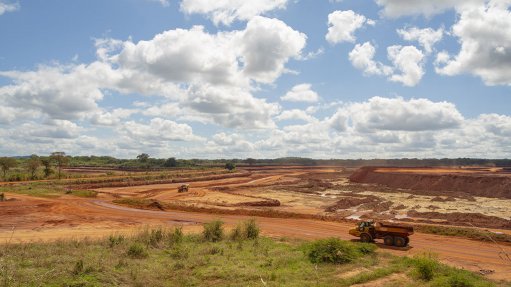Sasol scrambles to run on gas and hydrogen in South Africa
South Africa’s second-biggest emitter aims to be among the continent’s biggest buyers of renewable energy – but for now Sasol remains firmly tied to fossil fuels.
The company that made its name producing synthetic fuel and chemicals from coal, aims to reach net zero by 2050. That plan has been criticized as vague by activists and unrealistic by some analysts. The Organisation of Petroleum Exporting Countries' recent surprise production cut may also spur some energy companies to revisit their green goals in light of higher oil prices, which largely determine the value of Sasol’s products.
Curbing emissions will be an especially heavy lift for Sasol – its biggest plant produces more greenhouse gas than the global operations of oil companies BP or Marathon Petroleum Corp. CEO Fleetwood Grobler said the company is committed to its green future; the company just needs profitability to get there.
That starts with the dirtiest fossil fuel, which has been the company’s lifeblood since it was founded in 1950 and what has made its Secunda plant in central South Africa the world’s single most-polluting site.
“We’ve got a focus on coal quality that’s impacting our operations,” he said in an interview at the company’s headquarters in Johannesburg. Sasol has exhausted the richest deposits at its mines and what’s left doesn’t work as well in processes that convert the mineral into fuel, he said. “We are working hard to remediate that.”
Despite the recent uptick, volatility in the oil price also has Grobler concerned, particularly if crude prices fall toward $40 a barrel. “I would be really worried at that point,” he said.
COAL FOR GAS
Sasol’s strategy to cut emissions by 30% by 2030 also involves displacing one fossil fuel with another. Reducing the 40-million tons of coal it mainly uses to make fuel each year by a quarter will mean finding enough natural gas, which is more efficient and creates lower emissions, Grobler said.
Analysts are skeptical. “We still struggle to see how more gas makes long-term sense,” JPMorgan Chase & Co said in a November research note. The US lender also found that investors, especially in Europe, are wary of the stock. “An increasing number find it difficult to justify owning Sasol as climate concerns mount,” it said.
Grobler said that while the company arrived late to the green transition – it only came up with a plan around early 2021 – investors will be able to see its progress over the next five years.
“What shareholders are looking for is to see how we remain profitable, how do we remain committed to our outcomes of greenhouse gas reduction targets and how do we remain relevant beyond that and still be a profitable company,” he said.
ENOUGH GAS
Sasol’s cheapest source of natural gas is the company’s own fields in Mozambique that bring the fuel to its operations through the 537-mile Rompco pipeline. The company is spending $1-billion to find more in the region because it’s “concerned” about finding enough to replace coal beyond 2028, Grobler said. “We are doubling down on our exploration in Mozambique,” he said.
Otherwise the company can fall back on imports of liquefied natural gas, a decision Sasol will need to make from 2025, allowing three years to prepare for the supply, he said. Import terminals capable of unloading the fuel in Maputo and a potential South African project in Richards Bay are still in planning phases.
Sasol’s largest plant, the Secunda complex about 130 km from Johannesburg – which produces more climate-warming gases than either Portugal or Norway – will need to more than double the proportion of gas used from 7%, according to Grobler.
Still, activists have been withering about Sasol’s approach.
“The lack of adequate details, accountability measures and incentives means that Sasol does not have a feasible, measurable plan for it to achieve its emission reduction targets,” said Tracey Davies, director of Just Share, a Cape Town-based activist group that’s tried to enlist shareholders in scrutinizing Sasol’s plans.
As Sasol transforms, it will also pay a growing fee for the carbon it emits. Grobler points out that South Africa is the only place where the company, which also operates in the US and Europe, pays a carbon tax. CFO Hanre Rossouw has warned that the levies could potentially cut into the business and its green transition plans.
GREEN HYDROGEN
The use of renewables for electricity will be another major element of the company reaching its 2030 target. Sasol has signed agreements with developers, including Air Liquide and TotalEnergies, for almost half of the capacity it will need to meet its 1.2-gigawatt renewable goal.
Adding more renewables to the mix will be difficult. South Africa has become overwhelmed by record power outages, while its program to buy electricity from private clean energy projects has been slowed by a lack of grid connections. State-owned utility Eskom Holdings governs the process that determines which stations get plugged in, Grobler said.
Sasol is also exploring a green hydrogen project on South Africa’s west coast, which it hopes will provide an even cleaner fuel to someday replace natural gas. The Boegoebaai project would include a port developed by the struggling State-owned port and rail company Transnet.
It’s another plank in Sasol’s complicated green transition plans that will require even more renewable energy.
The Boegoebaai project is ending a prefeasibility study and is “a work in progress,” Grobler said, declining to estimate the cost of the green hydrogen plans. “That is still in very early phases.”
Comments
Press Office
Announcements
What's On
Subscribe to improve your user experience...
Option 1 (equivalent of R125 a month):
Receive a weekly copy of Creamer Media's Engineering News & Mining Weekly magazine
(print copy for those in South Africa and e-magazine for those outside of South Africa)
Receive daily email newsletters
Access to full search results
Access archive of magazine back copies
Access to Projects in Progress
Access to ONE Research Report of your choice in PDF format
Option 2 (equivalent of R375 a month):
All benefits from Option 1
PLUS
Access to Creamer Media's Research Channel Africa for ALL Research Reports, in PDF format, on various industrial and mining sectors
including Electricity; Water; Energy Transition; Hydrogen; Roads, Rail and Ports; Coal; Gold; Platinum; Battery Metals; etc.
Already a subscriber?
Forgotten your password?
Receive weekly copy of Creamer Media's Engineering News & Mining Weekly magazine (print copy for those in South Africa and e-magazine for those outside of South Africa)
➕
Recieve daily email newsletters
➕
Access to full search results
➕
Access archive of magazine back copies
➕
Access to Projects in Progress
➕
Access to ONE Research Report of your choice in PDF format
RESEARCH CHANNEL AFRICA
R4500 (equivalent of R375 a month)
SUBSCRIBEAll benefits from Option 1
➕
Access to Creamer Media's Research Channel Africa for ALL Research Reports on various industrial and mining sectors, in PDF format, including on:
Electricity
➕
Water
➕
Energy Transition
➕
Hydrogen
➕
Roads, Rail and Ports
➕
Coal
➕
Gold
➕
Platinum
➕
Battery Metals
➕
etc.
Receive all benefits from Option 1 or Option 2 delivered to numerous people at your company
➕
Multiple User names and Passwords for simultaneous log-ins
➕
Intranet integration access to all in your organisation






















